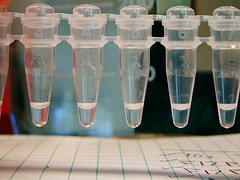PCR Troubleshooting Guide
| PCR Troubleshooting Guide |
 |
 | ||||||||||||||||||||||||||||||||||||||||||||||||||||||||||||||||||||||||
The following guide can be used to troubleshoot PCR reactions. Additional tips for optimizing reactions can be found in the technical reference section of our website.
|
20101230.JPG
The Essential PCR Troubleshooting Checklist |

 Routine PCR? Let’s be honest, there’s no such thing. Even with the simplest PCR reaction things can go wrong, so you need to have a good checklist of ideas for troubleshooting and rectifying the problem. Today I have brainstormed all of the ways I can think of to approach problems with standard PCR reactions.
Routine PCR? Let’s be honest, there’s no such thing. Even with the simplest PCR reaction things can go wrong, so you need to have a good checklist of ideas for troubleshooting and rectifying the problem. Today I have brainstormed all of the ways I can think of to approach problems with standard PCR reactions.
I’ve inevitably missed some things out so please chip in if you can think of anything else to add. I will add your ideas to the list to make it a resource we can all refer to.
No amplification
1. Try the reaction again, you may have missed something out.
2. Check that the polymerase buffer has been fully thawed and mixed thoroughly.
3. Check that the primers have been diluted to the correct concentration.
4. Make up a new dNTP solution. dNTPs can be destroyed by repeated freeze-thaw cycles
5. Re-make the template DNA, especially if you are working with genomic DNA. Old stocks may be degraded or sheared.
6. Use a different polymerase. If an amplification is problematic with a proofreading polymerase, I often try using good old Taq and this often solves the problem. Remember to sequence the insert though – if you are lucky there won’t be any significant mutations and you can use the insert as it is. Otherwise, re-do the PCR with a mixture of Taq and 1/10th concentration of your proof-reading enzyme and you should still get the same amplification with a lower error rate.
7. Change the annealling temperature. If the annealling temperature is too high, you obviously won’t get any priming at your desired sequence. On the other hand, an annealing temperature that is too low can result in such non-specific priming that no specific bands arise. The best way to find the optimum temperature is to use a gradient cycler and test a range from the lowest primer Tm to 10 degC below in 1 degC increments.
8. Try reactions with varying template concentrations. Your template concentration may be too low or the concentration of impurities in your prep may be too high. Try 5-10 parallel reactions with concentrations from 10 to 200 ng in a 50 microlitre reaction.
9. Check the cycler – are the temperatures and times as you expect?
10. Try the reaction in another cycler – the calibration of the one you are using may be off.
11. Try an additive. I find that DMSO is especially useful in problematic amplifications.
12. Redesign the primers – try to stick to the guidelines as closely as possible.
Non-specific band amplification
13. Re-do the reaction with a negative control (no template). The non-specific bands could be from contamination of one of your stocks with foreign DNA (probably yours!). If this is a problem, use new stocks, always use autoclaved PCR vials and wear gloves and a lab coat.
14. Increase the annealling temperature. Better yet, use a gradient PCR machine (see 7.)
15. Redesign the primers and make the 3′ longer. The extra bands may be from similar sequences to your target. Increasing the primer length will make them more specific for your target.
16. Increase annealling time if the non-specific products are shorter than your target. If they are longer than you target, reduce the annealling time.
17. Use less DNA template
18. Try touch-down PCR
Weak amplification of your target
19. Reduce the annealling temperature
20. Increase the annealling time
21. Increase primer, template and/or polymerase concentrations
22. Try touch-down PCR
23. Increase the number of cycles
24. Try an additive.
25. Clean up the isolated target and use it as the template in a new reaction.
…now, what have I missed out?
1. Basic PCR Procedure:
The basic PCR procedure includes 3 steps that are repeated 20 - 30 times. The process consists of: 1) denaturing: heating the double stranded DNA (to 90-95 C) to separate the strands, 2) annealing: lowering the temperature to allow primers to bind single stranded DNA, 3) elongation: the DNA polymerase adds nucleotides to the growing strand.
2. Why is Taq DNA polymerase used?
Taq DNA polymerase was isolated from Thermus aquaticus - a thermophilic bacterium. The enzyme is thermostable - even at temperatures over 90 C. The enzyme's ability to withstand the elevated temeratures required for denaturing steps during thermal cycling makes it well suited for the task. The purpose of the enzyme is to extend a DNA primer, using a DNA template.
3. What are PCR primers?
Primers are short synthesized DNA strands - typically 18-25 bp. They are designed to complement the nucleotides on the template DNA at the starting and ending points of the DNA fragment to be synthesized. Primer design is a complex process that involves taking into consideration the melting temperatures and, therefore G-C content. Read more about primer design.